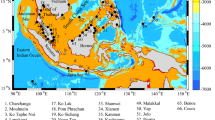Abstract
Tidal oscillations in the South China Sea (SCS) are mainly co-oscillating tides spread from tidal waves of the Pacific Ocean. The independent tide generated by the rising force of the moon and the sun is much smaller, but is important to the deeper area of the SCS and has strong effect to semidiurnal constituents.
Access this chapter
Tax calculation will be finalised at checkout
Purchases are for personal use only
Preview
Unable to display preview. Download preview PDF.
Similar content being viewed by others
References
Bagdanov, K. T., Nekrasov, A. B., and Lafrentiev, B. F. (1990) “Deep-sea mareograph study of tides in the open part of the South China Sea”, in: Selected Papers of Science Academy, Soviet Union, 733–735 (in Russian with English abstract).
Cao, De-ming and Fang, Guo-hong (1990) “A numerical model of the tides and tidal currents in Beibuwan Gulf”, Oceanologia et Limnologia Sinica 21(2), 105–113 (in Chinese).
Fang, Guo-hong (1986) “Tide and tidal current charts for the marginal seas adjacent to China”, Chin. J. of Oceanology and Limnology 4(1), 1–16.
Fang, Guo-hong and Cao, De-ming (1993) “Numerical simulation for the tides and tidal currents in the South China Sea”, (accepted by Acta Oceanogica Sinica) (in Chinese).
Huang, Qi-zhou (1989) “A general introduction to the tides and tidal currents in Nansha sea area, in A Comprehensive Research and Experiment Report of the Nansha Islands and the Adjacent Areas (I), Science Press, Bei**g, pp. 370–378 (in Chinese).
Huang, Qi-zhou, Wang, Wen-zhi, and Chen, Jun-chang (1987) “Calculation on typhoon storm surge set-up by the power station seashore of Daya Bay, Guangdong Province” in 1987 Proceedings of Coastal and Port Engineering in Develo** Countries, Vol. II, 2036–2045.
Huang, Qi-zhou, and Qiu, De-zhong “A sketch of tides and tidal currents in the areas adjacent to Nansha Islands”, (original manuscript).
Minh, D. C. (1975) “Propagation of tidal waves and tidal sea level variations of the South China Sea”, Okeanologia 15(4), 580–586 (in Russian, with English abstract).
Qiu, De-zhong, Gan, Zi-jun and Yu, **g-ja (1991) “The tides in the areas of Nansha Islands I. A report of tidal observation in Meijijiao”, in Proceedings of Ocean Environmental Research in Nansha Islands and the Adjacent areas (I), Hubei Scientific and Technologic Publication Press, Wuhan, pp. 46–50 (in Chinese).
Sergeev, Y. N. (1964) “The application of the method of marginal values for the calculation of charts of tidal harmonic constants in the South China Sea”, Okeanologia 4(3), 595–602 (in Russian).
Shen, Yu-jiang, Hu, Ding-ming, Mei, Li-ming, and He, Guo-** (1985) “Numerical computation of the tides in the South China Sea”, Trans. Oceanol. Limnol. 1, 1–110 (in Chinese).
Thuy, N. N. (1969) “Some peculiarities of the formation of tidal phenomena in the South China Sea”, Okeanologia 9(2), 235–249 (in Russian, with English abstracts).
Wang, Wen-zhi, Huang, Qi-zhou and Chen, Jun-chang, Tou, S., and Wong, K. K. (1986) “Numerical computation of waves in the sea around Hong Kong during Typhoon IRIS in 1976,1. Typhoon wind- field and water depth variations”, Nanhai Studia Marina Sinica 7, 129–142 (in Chinese).
Wang, Wen-zhi, Huang, Qi-zhou, and Chen, Jun-chang (1988) “Numerical simulation of the typhoon surges in the Daya Bay”, in Proceedings of the Third Chinese Oceanology and Limnology Science Conference, Science Press, Bei**g, pp. 34–35 (in Chinese).
Wu, Pei-mu (1983) “A numerical prediction model for the storm surge in the coast of East and South China Sea”, Acta Oceanologica Sinica 5(3), 273–283 (in Chinese).
Ye, An-le and Robinson, I. S. (1983) “Tidal dynamics in the South China Sea”, Geophys. J. R. Astr. Soc. 72, 691–707.
Yu, Ke-jun and Fang, Guo-hong (1990) “Three-dimensional numerical simulation of the storm surge and current generated by typhoon 8309 (Ellen, 1983)”, Oceanologia et Limnologia Sinica 21(5), 433–441 (in Chinese).
Yu, Mo-geng (1984) “A preliminary approach to the tidal characteristics in South China Sea”, Acta Oceanologica Sinica 6(3), 293–300 (in Chinese).
Author information
Authors and Affiliations
Editor information
Editors and Affiliations
Rights and permissions
Copyright information
© 1994 Kluwer Academic Publishers
About this chapter
Cite this chapter
Qi-zhou, H., Wen-zhi, W., Jun-chang, C. (1994). Tides, Tidal Currents and Storm Surge Set-Up of South China Sea. In: Di, Z., Yuan-Bo, L., Cheng-Kui, Z. (eds) Oceanology of China Seas. Springer, Dordrecht. https://doi.org/10.1007/978-94-011-0862-1_12
Download citation
DOI: https://doi.org/10.1007/978-94-011-0862-1_12
Publisher Name: Springer, Dordrecht
Print ISBN: 978-0-7923-2616-8
Online ISBN: 978-94-011-0862-1
eBook Packages: Springer Book Archive



